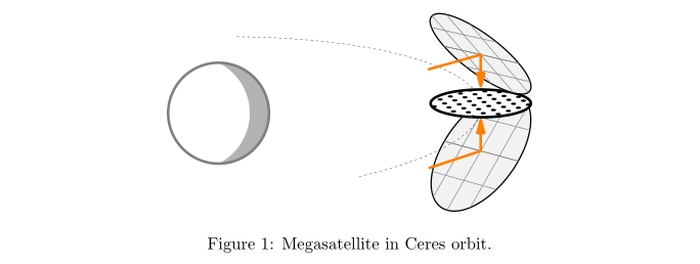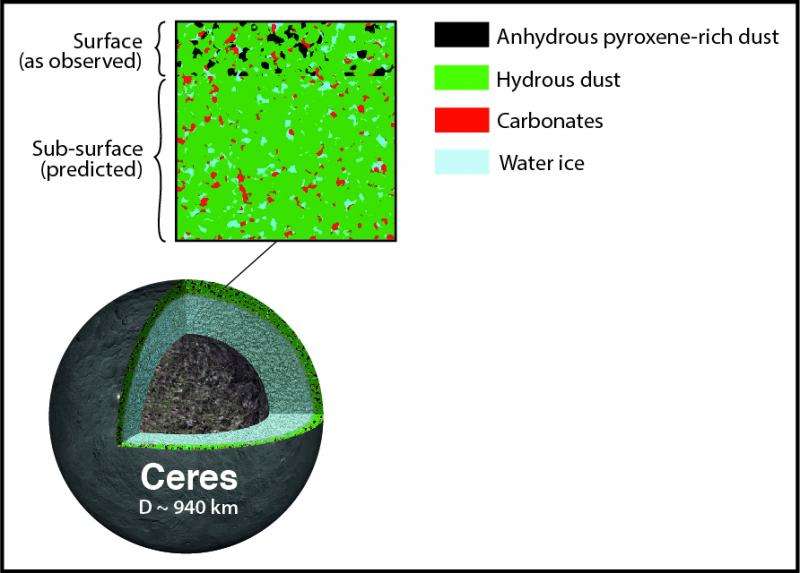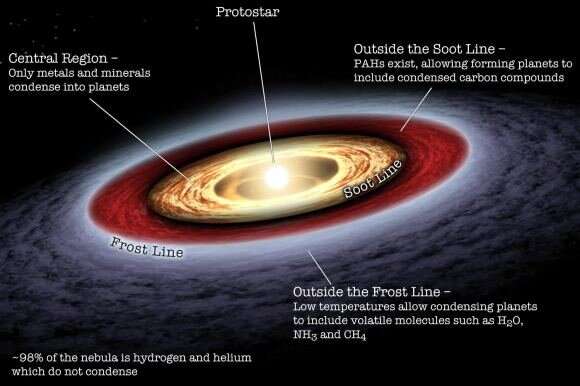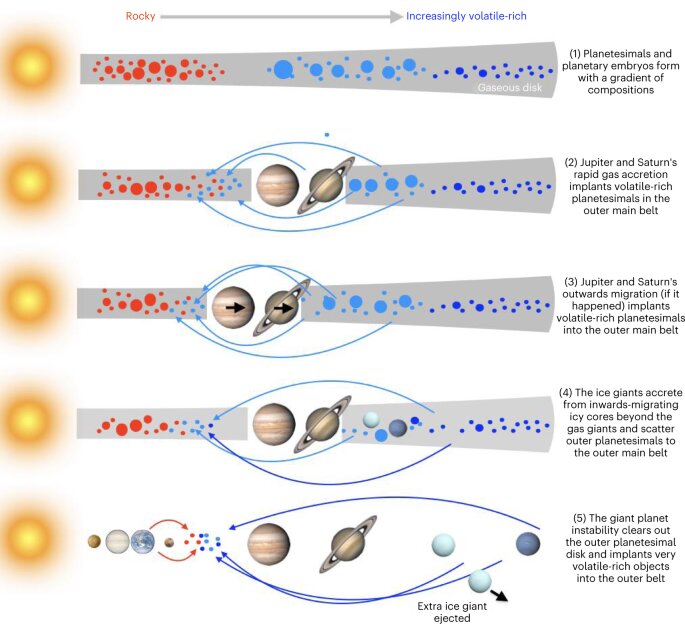New Mars Forums
You are not logged in.
- Topics: Active | Unanswered
Announcement
#51 2023-02-21 06:56:14
- Calliban
- Member
- From: Northern England, UK
- Registered: 2019-08-18
- Posts: 3,410
Re: Plutoids, Titanformation process, a cold treasure?
For bodies in the Kuiper Belt, sunlight intensity is around 0.1% that at Earth orbit. This would appear to make the prospect of solar power extremely difficult. However, research into solar sail technologies suggest that it should be possible to produce extremely thin solar sails constructed from aluminium, with mass of 1 gram per square metre. KBOs with a diameter of 100km, would have only ~0.1% of Earth gravity and gravity declines with square of distance from the centre of the body. A solar concentration disc constructed at the poles of such KBO could be built to truly enormous scale and could track the sun as the body rotates. A mirror with a diameter 100km would concentrate some 10.6GW of heat. A thermodynamic powerplant would convert this heat into electricity, with low grade waste heat being dumped into the ice of the KBO. This would gradually melt the ice. Eventually, the KBO would differentiate into a rocky centre, a warm water mantle and an icy crust.
The pressure at depth 10km would be ~1 bar. Such a body could support an aquatic ecosystem if humans were to provide the light required to drive the ecosystem. Convection within the water would be weak, due to the weak gravity and the ice sheet floating on the ocean could be many miles thick. Both would provide a lot of insulation. This would allow the ocean depths to remain comfortably warm, whilst the surface temperature of the ice remains at temperatures <100K. Human settlements could be constructed on or beneath the icy crust. Likely, humans would live in rotating buildings within an otherwise low-g environment. The aquatic ecosystem would provide food and would absorb wastes and waste heat from the human habitats. With gravity being 1000x weaker than Earth, it would also be relatively easy to create open air spaces within the mantle. Bouyant forces wouod be almost negible and the pressure gradient very shallow. Thin walled vessels made from thermo plastics could enclose habitable spaces, which are anchored either to the core or to the ice above.
The first attempt at this type of terraforming would probably be the Trojan asteroids, many of which appear to be captured centaurs. The outer moons of Jupiter and Saturn appear to be icy as well. At Jupiter distance from the sun, sunlight is 5% Earth intensity. So our concentrating mirror woukd gather 50% as much heat as it could at Pluto distance. The outer asteroid belt is dominated by C-type bodies, which are also water rich. Hygiea appears to be a water dominated body.
https://en.m.wikipedia.org/wiki/10_Hygiea
Last edited by Calliban (2023-02-21 07:27:19)
"Plan and prepare for every possibility, and you will never act. It is nobler to have courage as we stumble into half the things we fear than to analyse every possible obstacle and begin nothing. Great things are achieved by embracing great dangers."
Offline
#52 2023-02-21 10:41:32
- Void
- Member
- Registered: 2011-12-29
- Posts: 7,076
Re: Plutoids, Titanformation process, a cold treasure?
I value the information you provide.
I came across this yesterday: Asteroids:
http://newmars.com/forums/viewtopic.php … 92#p206392
Quote:
Since this topic is active, I guess this could be pinned to it: https://phys.org/news/2023-02-unknown-c … roids.html Quote:
FEBRUARY 20, 2023
Unknown class of water-rich asteroids identified
by Marietta Fuhrmann-Koch, Heidelberg UniversityImage Quote:
I wish they would describe some of the new class of object better.
Quote:
At the same time, the infrared spectra support conclusions as to the bodies’ chemical and mineralogical composition. Just like Ceres, there are minerals on the surface of the discovered asteroids that originated from an interaction with liquid water.
The small astronomical bodies are quite porous. High porosity is yet another characteristic shared with the dwarf planet Ceres and an indication that the rock material is still quite original.
“Shortly after the formation of the asteroids, temperatures were not high enough to convert them into a compact rock structure; they maintained the porous and primitive character typical of the outer ice planets located far from the Sun,” explains Dr Wladimir Neumann, a member of Prof. Trieloff’s team. He was responsible for the computer modelling of the thermal development of the small bodies.So, they might be like porous rock sponges with ices in much of the pore space?
Maybe the Trojans of Jupiter tend to be of this sort.
Done.
It suggests a different "Goldilocks Zone", one for emerging space faring cultures.
I suppose ignoring the Earth/Moon, it starts at Mars/Phobos/Deimos, and extends to Jupiter-Trojans-Callisto.
This is a general area where you can get rocky and icy materials in useful quantities, in my opinion.
Quote Calliban from previous post:
The first attempt at this type of terraforming would probably be the Trojan asteroids, many of which appear to be captured centaurs. The outer moons of Jupiter and Saturn appear to be icy as well. At Jupiter distance from the sun, sunlight is 5% Earth intensity. So our concentrating mirror woukd gather 50% as much heat as it could at Pluto distance. The outer asteroid belt is dominated by C-type bodies, which are also water rich. Hygiea appears to be a water dominated body.
https://en.m.wikipedia.org/wiki/10_Hygiea
You might also look at 24 Themis: https://en.wikipedia.org/wiki/24_Themis
Quote Calliban:
For bodies in the Kuiper Belt, sunlight intensity is around 0.1% that at Earth orbit. This would appear to make the prospect of solar power extremely difficult. However, research into solar sail technologies suggest that it should be possible to produce extremely thin solar sails constructed from aluminium, with mass of 1 gram per square metre. KBOs with a diameter of 100km, would have only ~0.1% of Earth gravity and gravity declines with square of distance from the centre of the body. A solar concentration disc constructed at the poles of such KBO could be built to truly enormous scale and could track the sun as the body rotates. A mirror with a diameter 100km would concentrate some 10.6GW of heat. A thermodynamic powerplant would convert this heat into electricity, with low grade waste heat being dumped into the ice of the KBO. This would gradually melt the ice. Eventually, the KBO would differentiate into a rocky centre, a warm water mantle and an icy crust.
The pressure at depth 10km would be ~1 bar. Such a body could support an aquatic ecosystem if humans were to provide the light required to drive the ecosystem. Convection within the water would be weak, due to the weak gravity and the ice sheet floating on the ocean could be many miles thick. Both would provide a lot of insulation. This would allow the ocean depths to remain comfortably warm, whilst the surface temperature of the ice remains at temperatures <100K. Human settlements could be constructed on or beneath the icy crust. Likely, humans would live in rotating buildings within an otherwise low-g environment. The aquatic ecosystem would provide food and would absorb wastes and waste heat from the human habitats. With gravity being 1000x weaker than Earth, it would also be relatively easy to create open air spaces within the mantle. Bouyant forces wouod be almost negible and the pressure gradient very shallow. Thin walled vessels made from thermo plastics could enclose habitable spaces, which are anchored either to the core or to the ice above.
That inspired me to think of this: 
In fact the rings could be expanded out a very great amount. And of course I agree that the habitations in the asteroid proper can be quite good.
If we could adopt from this item which seems to have emerged from the Finns: https://www.sciencealert.com/could-huma … anet-ceres
Image Quote: 
So, this thing would have a large amount of Synthetic Gravity devices embedded in it with magnetic bearings.
For Ceres, a ring supporting itself against gravity might be a challenge.
But for smaller objects, perhaps it could be done. In a manner a bit similar to a space elevator, you might have a ring so big that the spin habitats would be on its outer edge, and would be so far from the gravitational center as to weigh very little.
It's a maybe.
A weird thing to think about is that the ring would be sun synchronous, so in a year, it would rotate on it's axis once, so there would be a bit of centrifugal force, against the gravity of the large asteroid, I think.
????
![]()
Fun Stuff.
That would be a really big disk.
Done.
Last edited by Void (2023-02-21 11:14:26)
Done.
Offline
#53 2023-02-21 13:44:23
- Void
- Member
- Registered: 2011-12-29
- Posts: 7,076
Re: Plutoids, Titanformation process, a cold treasure?
Relating to the previous two posts, I thought these additional articles were worth a look:
https://phys.org/news/2017-01-ceres-ast … laged.html
JANUARY 20, 2017
Observations of Ceres indicate that asteroids might be camouflaged
by SETI Institute
Image Quote: 
https://phys.org/news/2022-05-ceres-solar-migrated.html
Quote:
MAY 19, 2022
Ceres probably formed farther out in the solar system and migrated inward
by Evan Gough, Universe Today
Image Quote: 
Image Quote: 
https://phys.org/news/2021-08-discovery … -belt.html
Quote:
AUGUST 2, 2021
Discovery of very red bodies in the asteroid belt that resemble trans-Neptunian objects
by ISAS
So, this region has much of the materials needed for a human/technological culture.
So, it does look like the primary path is Mars/Phobos/Deimos, and then out to the asteroid belt, all the way out.
As you have said Calliban, mirrors should work just fine in those regions.
Thanks for starting the discussion.
Done.
Last edited by Void (2023-02-21 13:56:18)
Done.
Offline
#54 2024-02-21 11:02:43
- Void
- Member
- Registered: 2011-12-29
- Posts: 7,076
Re: Plutoids, Titanformation process, a cold treasure?
This is interesting:
Kuiper Belt:
https://www.msn.com/en-us/news/technolo … r-BB1izCDK
https://phys.org/news/2024-02-nasa-hori … uiper.html
Quote:
FEBRUARY 20, 2024
Editors' notes
NASA's New Horizons detects dusty hints of extended Kuiper Belt
by NASA
The Kuiper belt may be larger than thought, or there may be a second Kuiper belt.
Done
Last edited by Void (2024-02-21 11:05:31)
Done.
Offline
